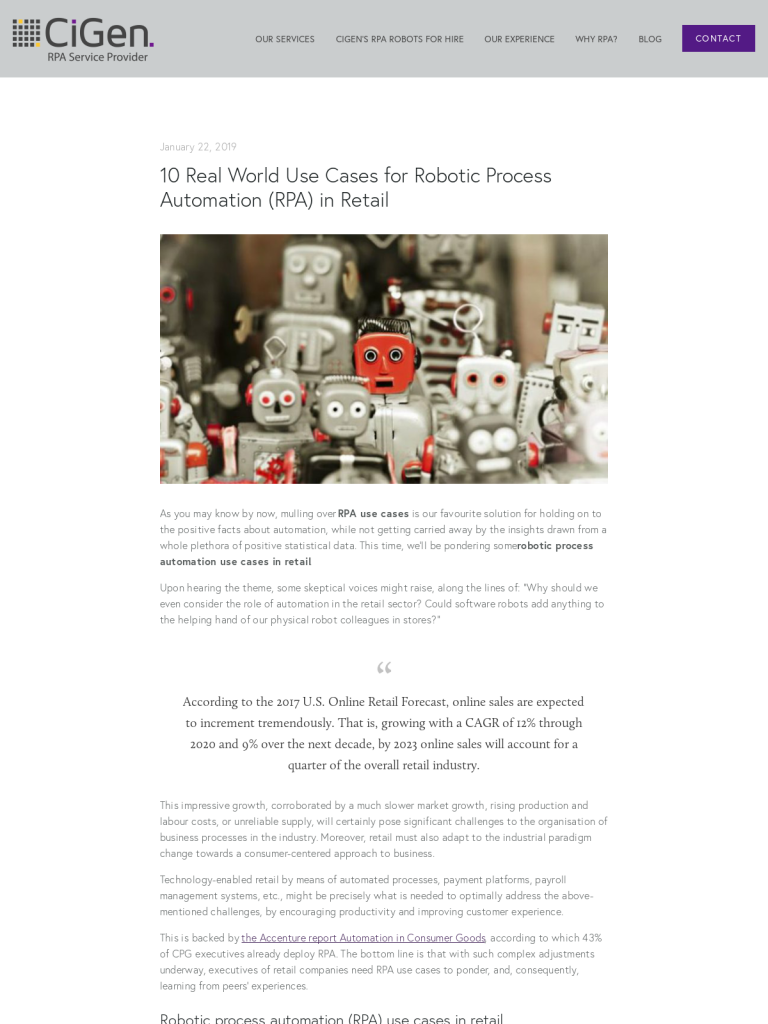10 Real World Use Cases for Robotic Process Automation (RPA) in Retail
Original post from https://www.cigen.com.au/cigenblog/

As you may know by now, mulling over RPA use cases is our favourite solution for holding on to the positive facts about automation, while not getting carried away by the insights drawn from a whole plethora of positive statistical data. This time, we’ll be pondering some robotic process automation use cases in retail.
Upon hearing the theme, some skeptical voices might raise, along the lines of: “Why should we even consider the role of automation in the retail sector? Could software robots add anything to the helping hand of our physical robot colleagues in stores?”
“According to the 2017 U.S. Online Retail Forecast, online sales are expected to increment tremendously. That is, growing with a CAGR of 12% through 2020 and 9% over the next decade, by 2023 online sales will account for a quarter of the overall retail industry.”
This impressive growth, corroborated by a much slower market growth, rising production and labour costs, or unreliable supply, will certainly pose significant challenges to the organisation of business processes in the industry. Moreover, retail must also adapt to the industrial paradigm change towards a consumer-centered approach to business.
Technology-enabled retail by means of automated processes, payment platforms, payroll management systems, etc., might be precisely what is needed to optimally address the above-mentioned challenges, by encouraging productivity and improving customer experience.
This is backed by the Accenture report Automation in Consumer Goods, according to which 43% of CPG executives already deploy RPA. The bottom line is that with such complex adjustments underway, executives of retail companies need RPA use cases to ponder, and, consequently, learning from peers’ experiences.
Robotic process automation (RPA) use cases in retail
Let’s have a look at some representative robotic process automation use cases in retail. The list should clarify what it is that RPA in retail can do, and, consequently, provide a substantial justification for its use.
1. Sales analytics
Comprehensive analysis of large amounts of sales data is fundamental for marketing and consumer behaviour analysis. It is a necessary condition for a wide range of retail decisions concerning, e.g. trade promotions, new product introductions, churn rate minimisation.
Automated analytics provides easy access to exhaustive reports providing real-time insights of customers’ behaviour and corresponding customer preferences. As such, it is a very useful tool for discerning the parameters that influence clients’ dropping out of services, which allows timely deployment of specific actions in order to retain them. Moreover, future-oriented analysis allows accurate sales forecasting, which is a supporting pillar of stock optimisation.
2. Demand and supply planning
The integrative capacity of RPA technology allows to streamline data gathering, formatting, and standardisation, plan simulations, exception finding, i.e, all the necessary steps towards devising realist and efficient business plans. This leads to improved capacity and assets management, and hence, to a boost in productivity.
3. Store planning
These are some of the processes highly relevant for the ‘old school’, in-store retail. Retailers attempt to fit with the particular preferences of consumers who regularly shop in specific stores, based on demographic criteria such as ethnicity, age, social status, etc. The guiding principle is that the layout should match specific preferences, which depend on these criteria.
However, manual layout store segmenting can only take into account a few high-level facts, because the nuances arising from sales data go beyond humans’ ability to handle complex segmenting modalities. Given its analysis capacity (see use case 1), this is what robotic process automation in retail brings in: the ability to make use of fine-grained data to create store-specific merchandise disposal, optimally fit with what customers want most.
The upshot is a personalised shopping experience, which promises to boost expenditures, and thereby to increase profit.
4. Marketing planning
Trade promotions are the paradigmatic illustration of business processes in the marketing sphere. When performed manually, these are among the most expensive in the retail industry. To better understand why this is the case, just consider the fact that data collection and analysis are mandatory prerequisites of productive trade promotions.
Software robots can do this much faster and more accurately than human employees entering data in spreadsheets could. A very concrete example of marketing processes that call for automation is rebate management in the food industry, a kind of sales promotion that food retailers use primarily as incentives or supplements to product sales. According to Colin Carroll, automation of rebate processes is basically a tool to increase price effectiveness by removing all variable costs.
5. Launching new products
There are two main preconditions of new product introduction. On the one hand, detailed analytics regarding what might get shoppers more excited.
According to (1) above, RPA is very trustworthy in this respect. Further, fruitful collaboration is the keyword in describing the processes that underpin launching new products – the more streamlined the communication between R&D, manufacturing, and marketing departments, the more effective and to-the-point the introduction of new products. As an epitome of integrative capacity, robotic process automation allows retailers to modify pricing, production and stocks in close agreement with customers’ preferences.
6. Product categorisation
A crucial task when it comes to product categorisation in multinational companies, is to achieve a necessary degree of correspondence between local and global stock keeping units (SKUs). Given significant cultural variation, it is likely that products across different markets have different definitions and constituents, and hence, they require different marketing strategies.
The effectiveness of these strategies depends on appropriate product categorisation. Software robots can easily (i.e., quickly and quasi-error-free) process data from retailers and vendors, incoming in multiple data formats such as texts, images, etc., in order to match the local datasets to global standards. According to a report from Everest Group, automation can lead to 98.5% accuracy in product categorisation.
Thank you. We will be in touch shortly.
7. Customer support management
These processes are vital in the context of the new, customer-centered retailing. In order to stay consistent with the boost of online commerce, the provision of 24×7 customer support is a necessary ingredient of competitive retailing.
Robotic process automation in retail is an appropriate technological development to rely on, because customer records can be easily managed across multiple systems by synchronising CRM information. This also allows more convenient customer on-boarding from websites, preparing data for subscription renewals, as well as timely complaint management.
8. Delivery tracking
With the use of software robots, orders can be easily tracked, and real time shipment updates can be delivered to clients. If you’re tempted think this is no such big deal, think again! This way, clients just don’t have to take any time out of your customer portal, because bots can gather order-related information from external partners and deliver it right there.
Once this is done, they can also collect customers’ feedback, which is a tremendous resource for further retailing decisions, to be dealt with by proper analytics.
9. Order and invoicing
Use of optical character recognition, and the capacity to deal with various data formats, e.g., Word, Excel, email, allows automated import of orders and invoices into the retail company’s enterprise resource planning (ERP). Both suppliers and customers can then benefit from prompt delivery.
10. Automated checkout
Just think about the many times when you’d have wanted to drink a bottle of water, but decided to wait until later simply because the store seemed hellishly crowded and you just couldn’t stand all that waiting in line. With the help of RPA, your retail company might help its customers escape this by automating the checkout.
Conclusion
RPA use cases in retail are based on peers’ real experiences, and they provide a very useful learning environment, by way of good applied examples. The list above is thus meant to show which processes in the retail industry are best suited for automation and why. They also provide directions for approaching the current challenges to the retail sector that we mentioned in the beginning. As a result, your RPA journey in retail will unravel on more solid ground, improving efficiency and freeing up employees’ minds for mission-critical tasks.
We end by mentioning once again that this article is part of a series of articles about the peculiarities of RPA manifesting themselves in application areas for different industries. If you found the information useful, please subscribe to the newsletter to make sure that you stay updated with news about the fast-evolving automation services.
Leave a Comment
You must be logged in to post a comment.








